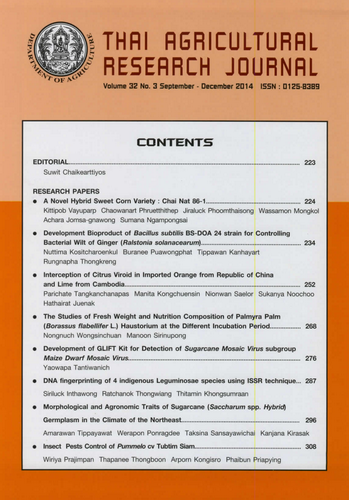Development Bioproduct from Bacillus subtilis BS-DOA 24 strain for Controlling Bacterial Wilt of Ginger (Ralstonia solanacearum)
DOI:
https://doi.org/10.14456/thaidoa-agres.2014.4Keywords:
Bacillus subtilis, antagonistic, Ralstonia solanacerum, bio ptoduct, gingerAbstract
A collection of 135 isolates of Bacillus subtilis was obtained from soil, manure and roots of chili, tobacco, banana, Siam tulip, potato and tomato across 9 provinces of Thailand. All isolates were laboratory tested for inhibiting growth of Ralstonia solanacearum. Eight isolates of B. subtilis viz. BS-DOA 24, BS-DOA 69, BS-DOA 97, BS- DOA 108, BS-DOA 114, BS-DOA 125 and BS-DOA 132 were found as effective antagonist of R. solanacearum. Afterward, the effectiveness of these 8 isolates was verified in the greenhouse experiment. Ginger rhizomes were soaked into solutions with 8 different isolates of B. subtilis before being planted in soil mixed with R. solanacearum . The results showed that only isolates of BS-DOA 24 and BS-DOA 123 could control the bacterial wilt in ginger for 60%. The BS-DOA 24 and BS-DOA 123 isolates were selected for the field experiment. Isolate of BS-DOA 24 suppressed the said disease in ginger for 68%. Thus, the BS-DOA 24 isolate of B. subtilis was selected to develop for R. solanacearum antagonist powder. The appropriate ratio of BS-DOA 24 bacteria per talcum was 1 : 4 (v/w) which induced the highest population of BS-DOA 24 to 1.1 x 10 10 CFU/g. After storing at ambient air (ca.30 °C) for 12 months and at 4 °C for 15 months, this antagonist powder showed the efficiency to control the bacterial wilt of ginger in greenhouse and wilt infested field up to 60 and 65%, respectively. The experiment was further carried out at the farmer’s field at Phetchabun Province, where the BS-DOA B. subtilis could control the disease of bacterial wilt for 62% with yield of 2,260 kg/rai (ca. 361.6 kg/ ha). The results suggest that antagonist powder based on BS-DOA 24 B. subtilis could be a potential source to control the bacterial wilt disease and for further commercial development.
Downloads
Published
How to Cite
Issue
Section
License
Copyright (c) 2017 วารสารวิชาการเกษตร (Thai Agricultural Research Journal)

This work is licensed under a Creative Commons Attribution-NonCommercial-NoDerivatives 4.0 International License.
Thai Agricultural Research Journal



